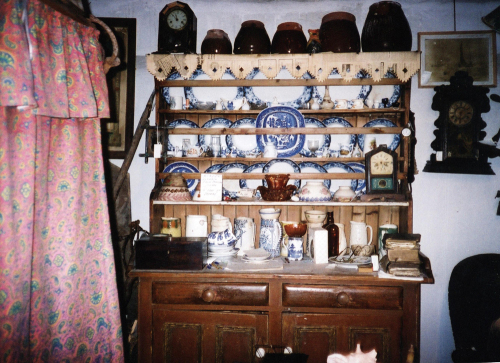An Island Dresser
The following account of a traditional dresser is taken from a publication by The Islands Book Trust ‘Back to the Wind, Front to the Sun’, a richly illustrated description of croft housing by Caroline Hirst based on the collections of the late Angus ‘Ease’ Macleod of Calbost, South Lochs. The book was launched on 18 October 2005 when Professor Jim Hunter gave the second annual Angus Macleod memorial lecture in Pairc school, Gravir.
On entering the living room (aig-an-teine), the most prominent piece of furniture would have been the dresser, which stood against the wall facing the central fire. It acted as both a work area for the housewife and a display area for the family’s precious items of china and other cherished items collected on travels away from the croft. The standard Highland design of dresser consisted of a base with either a two-door cupboard or an open area with a place to store large pots, above which would have been two drawers. The top of the dresser base would have acted as a work area for baking and the preparation of food. The display area was in the form of a plate rack, which sat above the base with three or four shelves. A distinctive feature of Scottish dressers is that each shelf incorporates a rail against which the plates lean and also prevents them from falling off.
Their leaning position would have also stopped the soot, which accumulated from the peat smoke, from collecting on the face of the plates. Like the box beds, the top of the dresser incorporated a sloping top, a further design feature to protect drips from the roof and soot spoiling the display area. On a regular basis the dresser would be taken outside and scrubbed, which over time gave it a bleached appearance. It was also a common practice to decorate the edges of the plate-rack shelf edges with lengths of scalloped newspaper as Angus showed in a photograph taken by himself of a fine example of a Lewis dresser from the Calbost Collection whilst still in Calbost.
Angus made in depth notes about this particular piece of furniture:
Posted by cepaircadmin | 0 commentsIt is a typical Lewis dresser which I found in Calbost. It has two drawers and two cupboard doors in the bottom part. The top and bottom parts are constructed separately and then married together into one unit by the two arm boards at each side. There were three shelves, which were used in a practical way to hold dishes (as well as a display cabinet). The large plates at the top, then the medium plates in the centre and the small plates in the lower shelf. Eggcups, salt and other nick-nacks were placed on the two top shelves including ornaments. On the lower shelf the big bowls and very often the small ones were placed on top of the big bowls. The surface of the bottom part of the dresser was the working top where the housewife prepared the food in conjunction with the table. The food was served from the working top of the dresser and after the meal the dishes were washed at the dresser and put away, in other words the dresser functioned as a kitchen.
All crofts had at least one domestic cow and very often two. The domestic cow was a form of factory. It produced in the first place milk from which a variety of other items of food were generated such as cream, crowdie, sour milk and buttermilk. Jugs and bowls were therefore used extensively and the milk itself was set in basins of white and brown clay in the bottom part of the dresser and in a portable cupboard. You will see the jugs on the inner side of the working top of the dresser.
You will see a large ‘ashet’ or blue tray in the centre of the dresser. That blue traditional pattern was used as the crockery of almost every house. Once the girls began to follow the fish gutting round the Scottish and English ports, they brought home with them nice ornamental glassware and many other trinkets, very often stating ‘A Present from Wick or Yarmouth.’ There are some such items in the Calbost Collection.
Do not overlook the Bibles on the right hand side of the dresser surface, the clock that was my Grandfathers, was bought in 1896 for 7/6, which today would cost £37.50 and is still going. Also the English lever breast watch and chain belonged to the man of the house when duly dressed. Hanging on the left of the dresser is a small period shaving mirror. It was common for the dresser top to be decorated with ‘scalloped’ newspaper edging.
